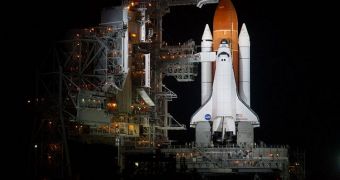Engineers at the Kennedy Space Center (KSC), in Florida, have already begun fueling the space shuttle Endeavour with the liquid oxygen and liquid hydrogen propellants that it needs to get to orbit.
The process was started at 11:35 pm EDT Sunday (0335 GMT Monday, May 16) and concluded about three hours later. Millions of gallons of fuel were poured into the massive, external fuel tank.
Each shuttle flight utilizes such a tank, in addition to two solid rocket boosters (SRB). Without them, no orbiter could make it way to the International Space Station (ISS) or low-Earth orbit (LEO).
As for Endeavour, its launch is scheduled to take place today, May 16, at around 8:56 am EDT (1256 GMT). Endeavour will blast off from the KSC Launch Pad 39A facility, Space reports.
At this point, the NASA weather office estimates a 70 percent chance of good weather. There are, however, some risks that storm clouds and winds will affect central Florida later today.
This launch, the next-to-last for the NASA Space Shuttle Program (SSP) was originally supposed to take place on April 19, but then got delayed to April 29. At that time, an electronic malfunction in one of the spacecraft's systems caused further delays.
At first, officials with the space agency announce that the flight will be delayed by a couple of days, which then turned into a week, and then finally two weeks. At this point, the orbiter is entirely flight-ready, mission controllers say.
The electrical components that failed during the first launch attempt have now been fixed, and an extensive set of tests has proven their readiness. The piece of equipment that was removed from Endeavour is now being analyzed by engineers.
“We have extremely high confidence that the problem is no longer on the ship,” explained the chair of Endeavour's mission management team, Mike Moses, during a recent press conference.
During STS-134, the shuttle and its six-astronaut crew will conduct a series of four spacewalks, during which they will install the $2 billion Alpha Magnetic Spectrometer (AMS) particle detector on the ISS.
The mission will last for about 14 days, NASA mission controllers say. When the shuttle returns, it will enter a decommissioning phase, after which it will be delivered to the California Museum of Science, near Los Angeles, where it's scheduled to go on permanent display.
“The space shuttle program, I think, will definitely be remembered for the amazing things that it has done,” STS-135 mission specialist Michael Fincke explained in a recent NASA interview.
“Everything that we’ve learned along the way, all the technology, all of the science that we’ve been able to bring in in these past years with the space shuttle, I think, is going to be remembered very nicely in the history books,” he added.

 14 DAY TRIAL //
14 DAY TRIAL //